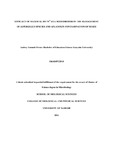| dc.description.abstract | Aflatoxins are mainly produced by mycotoxigenic fungi and are a global food safety concern and
human carcinogen. Maize is often contaminated with aflatoxin, making it unfit for human and
animal consumption. Currently, there are inadequate tested effective controls for aflatoxin
contamination of maize in Kenya. The objective of this study was to evaluate the efficacy of
fungicide Maxim XL 035 FS® in management of Aspergillus spp, Penicillium spp. and Fusarium
spp. and aflatoxin contamination of maize. This was done in vitro, green house and field
conditions. In in vitro assay, concentrations (0.5μl/ml, 1.0μl/ml, and 1.5μl/ml) of Maxim XL 035
FS® were used, and efficacy determined against A. flavus L-Strain and S-Strain, Pencillium spp.
and F. oxysporum. Sterile distilled water was used as a control. The fungicide (0.1μ) was placed
at the centre of the Petri dish and fungicide in four quadrats equidistantly and incubated at 37°C.
Radial growth of the test pathogens was measured from day two to determine the zone of
inhibition. Greenhouse trial, concentrations (0.5μl/ml, 1.0μl/ml and 1.5μl/ml) of fungicide was
assessed. Negative control had non treated seeds and inoculated soil; while positive controls had
treated seeds and non inoculated soil. Five replicates each were used. Sampling was done every
two weeks. Shoot wet weight and root wet weights were used as growth indicators. In the field,
concentrations (0.5μl/ml, 1.0μl/ml and 1.5μl/ml) of fungicide slurry per kg/maize were used on
seeds. Soil and maize debris from previous season were analyzed for microbial population.
Maize tissues and kernels were sampled on 3rd, 4th and 5th months, at hard dough stage and at
harvest and were analyzed for Aspergillus spp. incidence. Total aflatoxin level in kernels
sampled at harvest was determined by ELISA method. The incidence of A. flavus S-strain and Lstrain
was high in soil and maize debris before planting; while the incidence of A. caeletus, A.
tamarii and A. alliaceus was low. In vitro assay, Maxim XL 035 FS® had low activity
(mean=11.2mm) against Aspergillus spp. while under green house conditions, the fungicide was
more effective (mean 6.9mm) against A. flavus L strain at lower concentrations of 0.5μl/ml,
while it had no effect on the root and shoot wet weight. Dressing seeds before planting with
0.5μl/ml per kg of Maxim XL 035 FS® resulted in significant (p ≤ 0.05) decrease in total
aflatoxin levels in kernels sampled at harvest. This resulted in a significant decline (40%) in
levels of total aflatoxin in harvested kernels. High incidence of Aspergillus spp. in soil and
harvested kernels indicates that Aspergillus inoculum is widespread in the environment, soil and
kernels in the study area. The fungicide had some effect on the fungal population Since Maxim
XL 035 FS® had some activity against various mycotoxigenic fungi, farmers should be
encouraged to use it as a seed dresser. | en_US |

